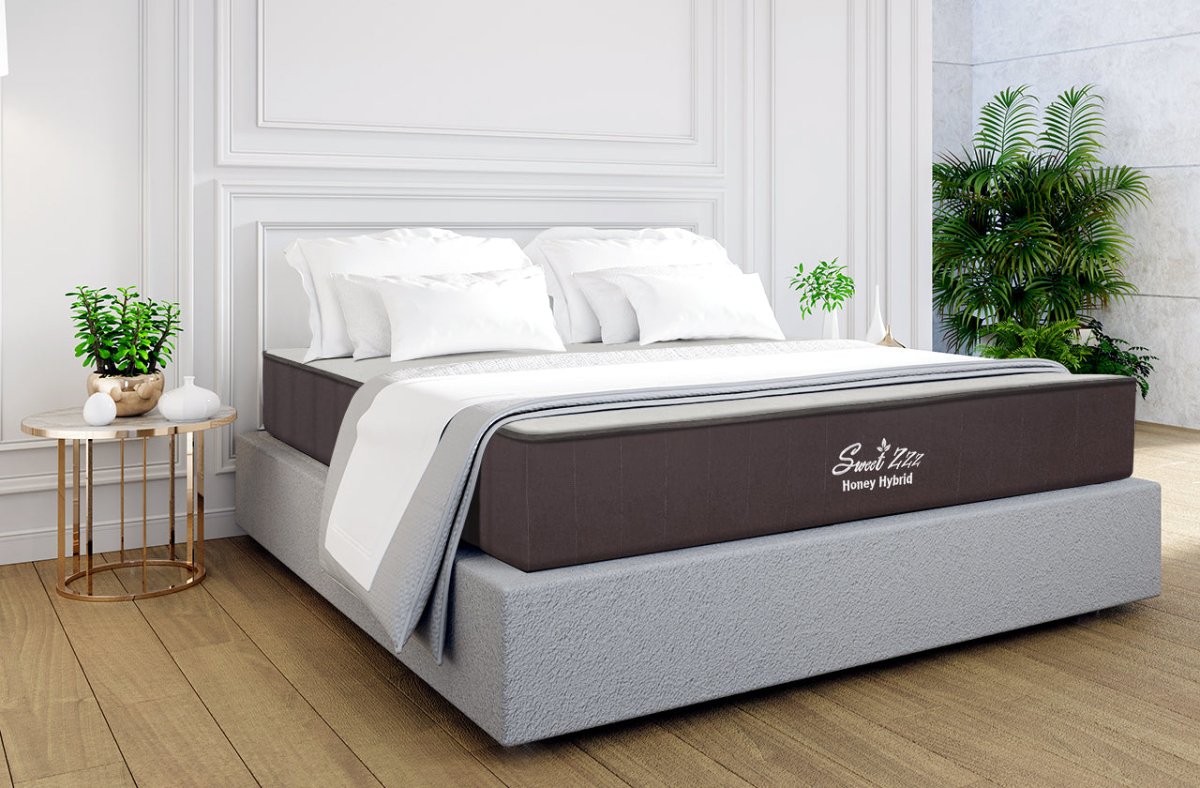5 Ways Your Mattress Affects Your Sleep

The quality of your sleep is greatly influenced by your mattress, a fact often underestimated in our pursuit of restful nights. While we often focus on lifestyle and health factors, the role of a mattress in shaping our sleep experience is paramount. This article explores the intricate ways in which your mattress impacts your sleep. From providing essential support to ensuring a hygienic sleep environment, we delve into the significant aspects of how a mattress can be the cornerstone of a good night's sleep. Understanding these factors will not only enhance your sleep quality but also improve your overall well-being.
1- Comfort:
The comfort level of a mattress is an important factor that significantly influences the quality of sleep. A comfortable mattress not only facilitates quicker sleep onset but also promotes deeper and more restorative sleep. Comfort in a mattress is subjective and varies from person to person; it encompasses various aspects like the softness, the firmness, and the overall feel of the mattress surface.
When a mattress strikes the right balance of softness and support tailored to an individual’s preferences, it can dramatically improve sleep quality. A mattress that's too hard can lead to pressure points and discomfort, disrupting sleep. Conversely, a mattress that is too soft may lack adequate support, leading to back pain or spinal misalignment. The ideal mattress provides a comfortable cushioning effect, conforming to the body's curves without sagging, thereby promoting proper spinal alignment and reducing discomfort.
Moreover, the surface texture and material of the mattress contribute to its comfort level. A material like natural latex, known for its resilience and comfort, can enhance the sleeping experience. Additionally, the top layer or the mattress cover plays a role in comfort, with a fabric like cotton offering a soft, breathable surface that adds to the overall comfort.
In essence, the comfort provided by a mattress is crucial for uninterrupted, high-quality sleep. It's the foundation of a restful night, ensuring that one wakes up refreshed and free from pain or stiffness. Investing in a mattress that aligns with personal comfort needs is an investment in overall health and well-being.
2- Support:
Support in a mattress is crucial for restful sleep and overall physical health. A supportive mattress maintains proper spinal alignment, distributes body weight evenly, and prevents pressure points. This support is essential to alleviate stress on the spine, neck, and hips, reducing the likelihood of waking up with aches and pains.
A supportive mattress adapts to the shape of the body without sagging excessively. Innerspring mattresses offer support through coil springs, while memory foam and latex mattresses provide support by conforming to the body's contours. The key is to find the right balance – a mattress that is too firm can push on the body's main pressure points, while one that is too soft may not offer enough support, leading to misalignment and discomfort.
For individuals with specific back problems or orthopedic concerns, the level of support a mattress provides is even more critical. Orthopedic mattresses, for example, are designed to offer targeted support and can greatly improve sleep quality and reduce pain for these individuals.
Furthermore, the support a mattress offers can change over time. As mattresses age, they can lose their supportive qualities, leading to less comfortable sleep and potential back problems. This makes it important to replace a mattress when it begins to sag or lose its structural integrity.
Overall, the support provided by a mattress is a vital component of sleep health. A supportive mattress contributes to better posture during sleep, can help alleviate pain and discomfort, and plays a significant role in achieving a deep, rejuvenating night's sleep.
3- Temperature Regulation:
Temperature regulation in a mattress is a key factor that significantly affects sleep quality. A mattress that effectively regulates temperature helps maintain a comfortable sleeping environment, which is essential for uninterrupted sleep. Temperature regulation in a mattress is influenced by its material composition and design, which can either contribute to heat retention or promote airflow and breathability.
Mattresses with good temperature regulation often incorporate materials such as latex, or specially designed innerspring systems that allow for better air circulation. These materials work to dissipate body heat rather than trapping it, helping to keep the sleeper cool throughout the night.
Moreover, the cover of the mattress also plays a role in temperature control. Covers made from a natural fiber like cotton is breathable and aid in heat dissipation and moisture-wicking, further contributing to a cooler sleep experience.
On the other hand, a mattress that lacks proper temperature regulation can lead to overheating, causing discomfort and frequent awakenings. This is particularly troublesome for people who tend to sleep hot or live in warmer climates.
In summary, effective temperature regulation in a mattress is vital for creating an optimal sleep environment. It ensures that the sleeper remains comfortably cool throughout the night, which is essential for deep, restful sleep.
4- Motion Isolation:
Motion isolation in a mattress is a critical feature, especially for those who share a bed. It refers to the ability of a mattress to localize movement, preventing one sleeper's movements from disturbing the other. This feature is particularly beneficial for light sleepers or those with different sleep schedules, ensuring that movements such as turning, tossing, or getting in and out of bed do not interrupt the other person's sleep.
Mattresses with excellent motion isolation typically feature materials that absorb and contain movement, such as latex and memory foam. Similarly, advanced innerspring mattresses with individually pocketed coils are designed to move independently, significantly reducing motion transfer compared to traditional innerspring systems where coils are interconnected.
Another aspect to consider is the mattress's overall design and construction. Some mattresses include additional layers or features specifically aimed at enhancing motion isolation. These might include high-density foam layers or specialized support systems that further localize movement.
Motion isolation is not only about improving sleep quality for those sharing a bed. It also contributes to overall sleep hygiene by allowing for an uninterrupted sleep cycle. A mattress that effectively isolates motion can make a substantial difference in achieving deep, restful sleep, particularly in a shared sleeping environment.
In summary, motion isolation in a mattress is a key factor in ensuring that each sleeper can enjoy an undisturbed night's rest. It is an essential consideration for couples, light sleepers, or anyone who values uninterrupted sleep, making it a significant feature to look for when choosing a mattress.
5- Allergen Accumulation:
Allergen accumulation in mattresses is an often overlooked aspect that can significantly impact sleep quality, particularly for individuals with allergies or respiratory sensitivities. Over time, mattresses can become a haven for various allergens, including dust mites, pet dander, pollen, and mold spores, which can trigger allergic reactions and affect breathing during sleep.
Dust mites are among the most common allergens found in mattresses. These tiny creatures thrive in the warm, humid environment provided by human bodies and feed on dead skin cells. Their waste products can cause allergic reactions and respiratory issues, such as asthma attacks, sneezing, and itchy eyes, which can disrupt sleep.
Moreover, in humid or poorly ventilated environments, mattresses can also become susceptible to mold and mildew growth. Exposure to mold spores during sleep can exacerbate allergies and respiratory problems, leading to poor sleep quality and health issues.
The materials and construction of the mattress play a crucial role in allergen accumulation. Some materials, such as latex and certain high-density foams, are naturally resistant to dust mites and mold, making them a better choice for allergy sufferers. Additionally, mattress protectors can help reduce allergen buildup, as regular washing can eliminate a significant portion of these irritants.
To mitigate allergen accumulation, regular maintenance, such as vacuuming the mattress, using allergen-proof covers, and ensuring good ventilation, is essential. These practices can help reduce the presence of allergens and improve the overall sleep environment.
In conclusion, the relationship between your mattress and sleep quality is both significant and complex. As we've seen, a mattress influences everything from spinal alignment and comfort to temperature regulation and allergen exposure. These elements collectively contribute to the overall quality of your rest. It's clear that a suitable, high-quality mattress is not just a bedroom accessory but a critical investment in your health and well-being. By understanding the key aspects of how a mattress affects your sleep, you can make informed choices that lead to more restorative, uninterrupted sleep, and by extension, a healthier, more vibrant life.






